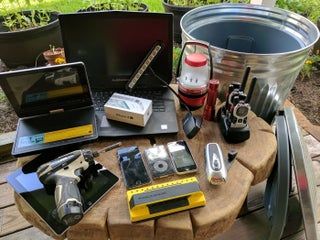A Faraday cage (or shield) is a device that shields against electromagnetic radiation. A continuous covering of conductive material or a mesh of such materials may be used to make a Faraday cage. This provides a shielding effect for anything kept within the cage and protects them from EM Radiation.
Why would you need a Faraday Cage?
There are several reasons a Faraday cage would be helpful for the average person. For example, if you have a laptop you want to protect from being hacked, you can store it in a Faraday cage. Or, if you have a cell phone that you want to protect from being tracked, you can store it in one.
A Faraday cage can also be useful for protecting a car with keyless entry from thieves.
Can you make your own DIY Faraday cage?
Yes, you can! In fact, it’s not that difficult to do. All you need is some conductive material and a way to seal it so that EM radiation cannot penetrate.
One popular method is to use aluminum foil. You can line a box with aluminum foil, or even wrap your device in it. Just make sure that there are no gaps in the coverage, or else EM radiation can still get through.
What can you use to make a Faraday cage?
But really, think out of the (Faraday) box and get creative. You can use all sorts of things around the house to DIY a Faraday cage either in conjunction with or without aluminum. These can be things like:
- Metal trash cans
- Cardboard box lined with aluminum foil
- An old microwave oven that has been gutted
- Galvanized steel pail
- Any metal container with a tight-fitting lid like cocktail shakers or other physical storage devices.
How To Make a Faraday Cage for your Phone
I know this sounds intimidating but really it’s not too bad! A faraday cage for your smartphone is as simple as wrapping your iPhone in a plastic wrap or bag, and then completely covering the plastic with aluminum foil with several layers of aluminum to ensure no electromagnetic interference penetrates and affects your device.
In order to improve EMP protection, some experts recommend at least three aluminum layers and additional layers of plastic wrap in-between aluminum layers. Think back to our post on mylar blankets which also use aluminum. You can maximize the benefits by “sandwiching” layers.
Can I place a faraday cage inside a bigger faraday cage?
Of course, you can! In fact, this is often how people make larger structures like vehicles or buildings EMP proof. By nesting smaller cages inside each other, you increase your protective layers and maximize your chances of success.
This works by having the innermost cage block the majority of the EM radiation while the outer cage(s) prevent any residual radiation from penetrating.
Can you turn your room into a Faraday cage?
You could, but then you’d have to live inside of a metal box which would be really uncomfortable (and probably not very healthy). BUT, you could have a designated closet or utility room lined with several layers of aluminum foil protection from EMP for emergency electronic devices.
You’d also want to make sure that none of the outlets in that room or area are being used. Even the smallest gap can allow electromagnetic radiation to enter. You’d also need to cover all of the walls, the floor, and the ceiling with aluminum foil.
So yes, it’s possible but not very practical for most people.
How effective is a Faraday cage?
As long as the cage is constructed properly, it can effectively shield against EM radiation. However, it’s important to note that no cage is 100% effective.
There are always going to be some ways for EM radiation to penetrate, whether it’s through gaps in the coverage or via reflections.
A well-constructed Faraday cage can provide a high level of protection and is often the best option for most people.
Safety Precautions for Faraday Cages
Shielding effectiveness is proportional to how much conductive material you use, so ensure you have adequate material to cover every part.
Remember that shielding can only prevent the transmission of electric fields, not magnetic ones. If possible, try to avoid storing items with a high moisture content inside your Faraday cage and keep any metal surfaces dry at all.
Do not rely on Faraday cages for long-term storage of items as they can slowly degrade over time.
Make sure your Faraday cage is properly grounded to prevent a build-up of static electricity which can damage electronics.
So there you have it! Now you know how to make your own Faraday cage and why you might need one. Get creative and start shielding your devices today.
Featured Image Source: https://www.pinterest.com/pin/803611127265922924/


[lasso rel="emergency-preparedness-more-a-manual-on-food-storage-and-survival-2nd-edition-revised-and-updated" id="35334"]